
MODERN WEBSITE DESIGN
Responsive coding ensures your website looks good on any device patients use.
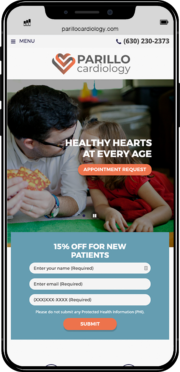
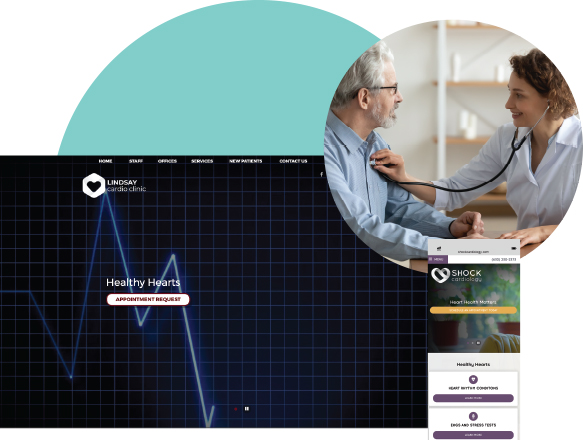
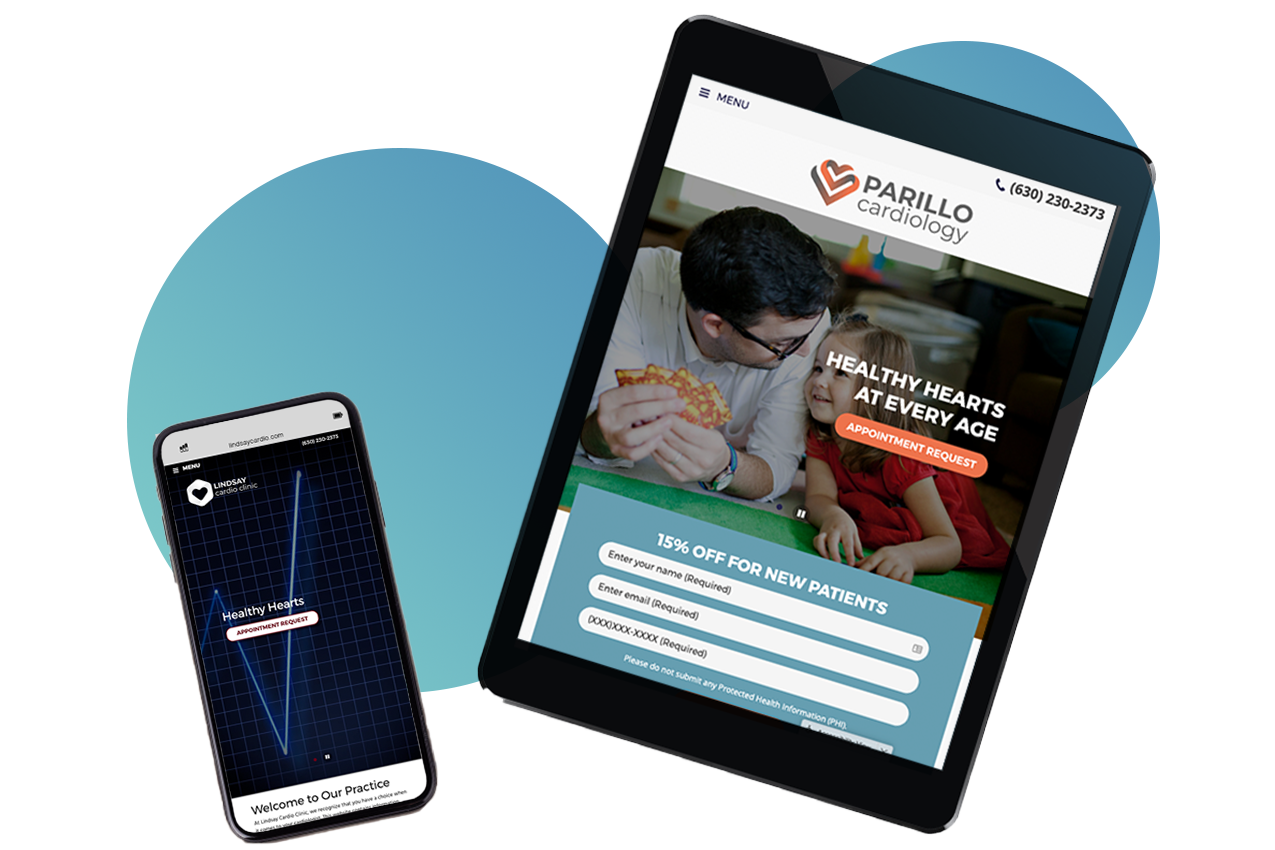
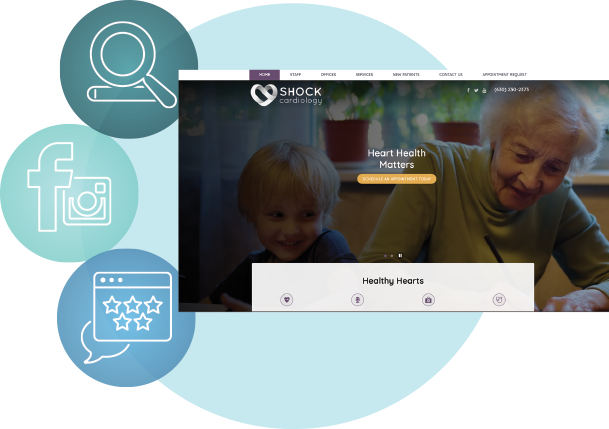

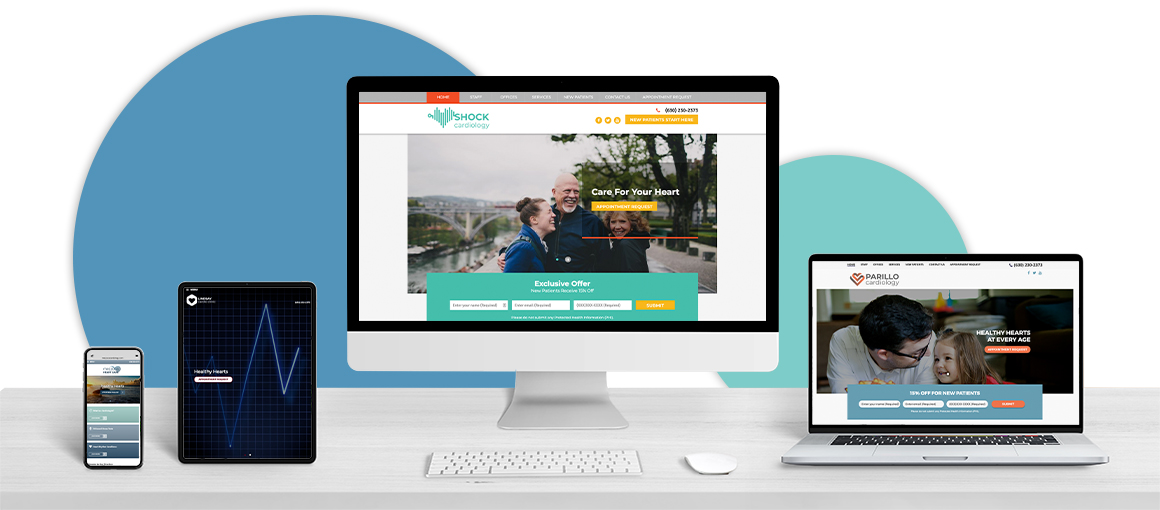
It is essential for a cardiology office or any other medical practice to have a robust web presence. Officite is aware of this, so we focus on developing bespoke websites highlighting a cardiology practice's qualifications, offerings, and patient-centric approach. These sites aren't just pretty; they're also easy to navigate and optimized for mobile devices, so prospective patients can get what they need from your practice, anywhere and at any time.
However, cardiology clinics must also do well in search engines like Google if they want to get noticed online.
Officite uses cutting-edge search engine optimization tools and methods to raise a clinic's profile on the web. Officite improves a cardiology clinic's visibility in search results by focusing on keywords, developing original content, and making technically sound cardiology websites for all medical practitioners who wish to take their cardiology practices to the next level.
Cardiology practices need to produce high-quality, helpful material to attract patients and build credibility as an industry leader. Blog entries, articles, and other instructional resources are just some content marketing services Officite provides to keep patients informed and involved. In addition to improving the practice's standing, this material also aids in patient education.
Online reputation and patient feedback play a crucial role in the healthcare industry. Officite equips cardiology clinics with the resources to keep tabs on their online reputation—every medical practice dreams of having a convenient and streamlined method. Professionally responding to negative criticism and encouraging satisfied patients to post positive reviews are two ways practitioners can earn respect and credibility in their local communities.
Officite can be crucial in assisting cardiology practices in maintaining a positive internet reputation. Officite utilizes programs that helps businesses keep tabs on what people say about them on reviews like Google, Yelp, Healthgrades, and more. By listening in on patient feedback, cardiology clinics can improve their services.
It would help if you got favorable evaluations from happy patients to have a good internet reputation. By utilizing tactics and tools developed by Officite, cardiology practices can increase the number of favorable ratings they receive from patients.
It's crucial to respond quickly and professionally to positive and negative patient feedback.
To help practices maintain a good reputation online, Officite provides tips on how to reply to reviews. By responding to negative feedback professionally and empathetically, they can help practices turn potentially disastrous situations around.
It is vital for a cardiology practice to know how its internet reputation stacks up against that of its rivals. By comparing their reputation to that of competing practices in the same city or locale, cardiology practices can use Officite to find ways to set themselves out from the pack. Patient feedback is an excellent source of information for service providers. Using patient feedback surveys, cardiology practices can assess their strengths and weaknesses with the aid of Officite.
The information must be consistent throughout all listings and directories for a positive internet reputation.
Officite can help you maintain consistent, professional information about your practice across your digital channels. Cardiology practices can measure the long-term results of their reputation management initiatives with the help of Officite's analytics and reporting tools. This data-driven method aids practices in making better decisions and adjusting their methods.
There are substantial changes required to cardiology websites and the way they manage patient information due to HIPAA. Healthcare providers like cardiology practices must comply with HIPAA standards because they handle patients' personal health information.
HIPAA mandates stringent patient confidentiality on cardiology websites. This necessitates the utmost secrecy and safety concerning the patient's medical records, appointment times, and other identifying details.
To gather and maintain sensitive health information online, websites may be required to seek patient authorization. The terms of this agreement should be specific, outlining exactly how the data will be used and stored.
Appointment requests and other forms requesting personal information from patients should be transmitted securely. Encryption protocols (like HTTPS) are commonly used for this purpose. HIPAA must strictly regulate access to patient records. Information about patients should be accessible only to those who need it, like doctors and nurses. Security logins and user roles can help cardiology websites limit access to those who need it.
Information about patients must be encrypted while it is being stored on the website's servers. It is crucial to have robust encryption methods that cover data at rest. Cardiology websites should have reliable data backup and recovery methods in place in the event of data loss or breaches.
It is crucial for compliance purposes to keep records of who accessed patient information and when. Any access to sensitive patient information on cardiology websites should be recorded. HIPAA mandates immediate reporting of affected persons and authorities in case of a patient information breach. Security incident response protocols are essential for cardiology websites.
Audience target identification for cardiology websites involves defining and understanding the specific patient demographics and characteristics the website aims to reach and engage with.
This step is crucial in tailoring the website's content, design, and marketing efforts to connect with the intended audience effectively. Conduct thorough market research to gain insights into the local or regional healthcare market. Understand the demographics, health needs, and preferences of the population in your area.
Create patient personas, which are detailed profiles of your ideal patients. These personas should include demographic information (age, gender, location), medical needs, preferences, challenges, and goals related to cardiology care. Analyze your existing patient database to identify common characteristics among your current patients. Look for trends in age, gender, medical conditions, and geographic location.
Study your competitors and their patient base. Identify gaps or opportunities in the market that your practice can leverage to attract specific patient groups.
Consider the sources of patient referrals to your cardiology practice. For example, if you receive many referrals from primary care physicians, tailor your website's content and messaging to align with what these referring doctors and their patients seek.
Conduct keyword research to understand what terms and phrases potential patients use when searching for online cardiology services.
This can help you optimize your website for search engines and align your content with patient search intent. Collect patient feedback on your website through surveys, interviews, or feedback forms. Ask about their preferences, online behaviors, and what information they find most valuable.
If you have an active presence on social media, analyze the demographics and interests of your followers to gain insights into the types of patients you're already reaching. Consult with referring physicians and healthcare professionals who collaborate with your cardiology practice. Understand their patient demographics and needs to ensure alignment in your marketing efforts.
A mobile-friendly layout is essential now for all cardiology websites. Since smartphones and tablets now account for most of the web traffic, your cardiology website must be optimized for mobile use.
If you want your site to look good on any size screen, test it across various devices. User-friendly navigation is crucial for site users to find the answers they need. Examine the logic and structure of your website's menus. Is it easy to use, with obvious navigation? Get the most essential information, including services, providers, and contact details, front and center.
Web pages that take too long to load can lose visitors and fall in search engine ranks. Assess your website's loading time with help from Google PageSpeed Insights. Improve performance by optimizing pictures and cutting down on extra code.
The layout needs to look nice yet come off as competent and reliable. Think about how you can best utilize images, typefaces, and color. Websites devoted to cardiology benefit from a streamlined medical aesthetic with calming hues and high-resolution photographs of the team and facilities.
The content you give needs to be straightforward and organized. Make your writing more readable by dividing it into sections with headings, subheadings, bullet points, and paragraphs. Infographics and films can be valuable tools for conveying complex medical information.
Make sure that people with disabilities can easily use your website. To ensure accessibility for all users, it is crucial to take measures such as supplying picture alt text, using appropriate headers, and conforming to web accessibility guidelines (WCAG).
Think about how you can improve your content's quality and usefulness. Does it respond to the issues that your patients have raised? Is it current with the state of healthcare today? Create attractive, educational, and patient-focused content to win their trust and loyalty.
Check the effectiveness of your website's appointment-setting features if you have them. Is it simple to use? Does it work with your office's time-tracking software without any hitches? Make it simple for patients to schedule visits and get confirmations.
A visually appealing website draws visitors in and conveys professionalism and trustworthiness.
Begin with a clean and professional design that aligns with the seriousness of healthcare. A minimalistic approach with a clear layout, soothing color palette, and elegant typography can set the tone for your cardiology website.
Invest in high-resolution images that showcase your healthcare professionals, state-of-the-art facilities, and compassionate patient care. High-quality photos create a positive impression and add credibility to your practice. Maintain consistency in design elements throughout your website, such as fonts, colors, and styles. This cohesiveness creates a polished and organized appearance.
Ensure that your website's navigation is intuitive and user-friendly. Visitors should quickly find the information they seek, whether it's about cardiology services, providers, patient resources, or contact details.
A responsive design is non-negotiable. Your website must adapt seamlessly to various screen sizes, including desktops, tablets, and smartphones. Mobile-friendly design is not only user-centric but also crucial for SEO rankings.
Incorporate ample whitespace around text and images to avoid visual clutter. Break up content into digestible sections using headings, bullet points, and paragraphs for improved readability. Visual aids like graphics and infographics can effectively convey complex medical information. Use them to illustrate cardiology procedures, explain conditions, or showcase treatment options.
Video content is engaging and informative. Consider creating videos introducing your cardiology team, explaining procedures, or offering patient testimonials. Videos can help build trust and establish a personal connection with your audience.
Craft patient-centric content that addresses common questions, concerns, and needs. Focus on providing valuable information that empowers patients and helps them make informed decisions about their heart health.
Choose readable fonts that enhance the overall user experience. Look for legible typefaces, maintain appropriate font sizes, and use font styles consistently throughout your website. Use color contrast effectively to ensure text is easily readable. Dark text on a light background or vice versa provides clarity and accessibility.
If your website includes contact forms or appointment scheduling, design them with user-friendliness. Keep forms concise and straightforward, requesting only essential information.
Marketing and branding for cardiology practices can set themselves apart from the competition by emphasizing their individual capabilities, values, and patient-centric approach. Find out what makes your cardiology clinic different from others in the area. It could be a unique area of expertise, innovative practice, individualized care, or outstanding patient results.
Create a memorable brand identity that stands for the ideals of your practice. Making a logo that sticks in people's minds, picking a color palette, and selecting fonts that exude professionalism and reliability are all part of this process. Promote your services by stressing how much you care about your patients. Remember that your clinic cares deeply about its patients' needs and problems and offers them full assistance at every stage of their treatment.
Promote the cardiology team's experience, training, and credentials. Patients desire assurance that their care providers have the necessary expertise. Incorporate genuine patient feedback and achievement stories into your online content and promotional materials. Sharing the experiences of successful patients can help establish credibility and confidence.
Make available on your website and social media channels helpful instructional material geared toward the needs of your patient base. You may promote your practice as a go-to resource for cardiology information by publishing informative articles, videos, and infographics. Consider any cutting-edge equipment, processes, or technology that sets your clinic apart. Patients are frequently attracted to medical facilities that are on the cutting edge of medical technology.
Like any healthcare marketing, cardiology marketing requires careful planning and execution to be effective. Avoiding common mistakes is crucial to ensure your marketing efforts deliver the desired results and maintain patients' trust. One of the most critical mistakes to avoid is violating patient privacy or failing to comply with the Health Insurance Portability and Accountability Act (HIPAA). Always ensure that any patient data, testimonials, or reviews shared in your marketing efforts are done in compliance with healthcare privacy regulations.
Using overly technical jargon and medical terminology in your marketing materials can alienate patients. Communicate complex medical information in a clear and patient-friendly manner to ensure understanding. Neglecting the importance of mobile responsiveness can result in a poor user experience for a significant portion of your audience. Ensure that your website and marketing materials are optimized for mobile devices.
Omitting clear and compelling CTAs can hinder your marketing efforts. Whether scheduling an appointment, signing up for a newsletter, or contacting your practice, CTAs guide users toward the desired action. Inconsistent branding, including variations in logo usage, color schemes, and messaging, can confuse patients and weaken your practice's identity.
Maintain a consistent brand across all marketing materials and channels.
Local SEO is essential for attracting local patients. Neglecting to optimize your website for local searches can result in missed opportunities. Ensure that your practice appears in local directories and search results. Failing to monitor and manage your online reputation can lead to negative reviews and unaddressed feedback. Engage promptly with patient feedback, whether positive or negative, to maintain a positive online image.
Neglecting to track and analyze the performance of your marketing efforts can result in wasted resources. Regularly review website analytics, conversion rates, and campaign data to make data-driven improvements. Low-quality or outdated content can diminish the reputation of your practice. Invest in high-quality, accurate, and up-to-date content that educates and informs patients.
Social media platforms can be valuable tools for patient engagement and brand building. Underestimating their potential or failing to maintain an active presence can be missed opportunities. Patient feedback can provide valuable insights into your practice's strengths and weaknesses. Ignoring or dismissing patient feedback can hinder improvements in patient care and satisfaction.
Approaching marketing without a clear strategy can result in disjointed and ineffective efforts. Develop a comprehensive marketing plan that outlines goals, target audience, tactics, and timelines. Ensure that all staff members interacting with patients, whether in person or online, are trained in proper communication and patient engagement. Inconsistent or unprofessional interactions can harm your practice's reputation.
Cardiology practices can harness the power of patient-centric content to educate, inform, and engage with their audience while building trust and credibility.
The first step in crafting patient-centric content is to understand your target audience. Consider cardiology patients' shared concerns, questions, and health issues. Are they seeking information about heart disease prevention, treatment options, or lifestyle changes? You can create content that addresses their specific concerns by empathizing with their needs.
Adopt a patient-centric tone in your content. Use "you" and "your" to speak directly to the reader, making them feel valued and understood. Avoid medical jargon and focus on clarity and empathy.
Patients often turn to the internet for reliable healthcare information. Your content should aim to educate and inform without overwhelming patients with medical jargon. Use clear and accessible language to explain complex concepts, procedures, and conditions. Always ensure the accuracy of your content to maintain trust.
Frequently Asked Questions (FAQs) are an excellent starting point for patient-centric content. Create a dedicated FAQ section on your website addressing common queries about cardiology topics, symptoms, treatment options, and more.
Keep your website's FAQ section updated as new questions arise. Include interactive features like comment sections, forums, or patient Q&A sections where patients can ask questions and discuss with healthcare professionals. Use relevant keywords and phrases in your content to improve search engine visibility. This ensures that your patient-centric content reaches a broader audience.
Creating patient-centric content for cardiology websites is a dynamic process that requires a deep understanding of patient needs, effective communication, and a commitment to providing valuable information.
Cardiology practices can become trusted sources of healthcare information and support by focusing on education, engagement, and empathy, ultimately strengthening patient relationships and improving overall health outcomes.
Empower patients to make informed decisions about their health. Provide information about treatment options, risks, benefits, and lifestyle modifications. Offer insights into the pros and cons of various procedures, medications, and interventions.
Collaborate with your cardiology team to create content that showcases their expertise. Feature articles or videos authored by your cardiologists on specific topics related to heart health, treatment options, and prevention.
Acknowledge and address patient fears and concerns openly and compassionately. Discuss common anxieties related to cardiac procedures, recovery, and lifestyle changes, offering reassurance and practical advice. Cardiology is a rapidly evolving field. Ensure your content reflects the latest advancements, guidelines, and research findings. Outdated information can erode trust and credibility.
PPC campaigns for cardiology practices can be a highly effective way to drive traffic to cardiology websites and attract potential patients. Conduct thorough keyword research to identify the most relevant and high-converting keywords for cardiology services. Include terms related to cardiology conditions, treatments, and locations. Use keyword research tools and consider long-tail keywords for more targeted campaigns.
Implement negative keywords to exclude irrelevant search queries and prevent your ads from showing to users unlikely to become patients. For example, if your cardiology practice doesn't offer pediatric cardiology services, include "pediatric" as a negative keyword.
Utilize location-based targeting to ensure your ads are shown to users in your practice's service area. This is crucial for attracting local patients.
Ad extensions can provide additional information and make your ads more compelling. Site link extensions, callout extensions, and location extensions can enhance the visibility and appeal of your ads.
Be sure to write persuasive ad copy highlighting your cardiology practice's unique benefits and services. Use clear and concise language that addresses the needs and concerns of potential patients. Include a solid call to action (CTA) such as "Schedule an Appointment Today."
Finally, ensure your landing pages are highly relevant to the ad copy and keywords. Landing pages should provide comprehensive information about the services or conditions mentioned in the ad and include clear contact options or appointment scheduling forms. Continuously perform A/B tests on ad headlines, copy, CTA buttons, and landing pages to identify what resonates best with your target audience and improves conversion rates.
Optimize your PPC campaigns for mobile users. Ensure that your landing pages are mobile-responsive and consider using mobile-specific ad extensions like call extensions. Implement remarketing campaigns to re-engage users who have visited your website but didn't take action. Show tailored ads to remind them of your cardiology services and encourage them to schedule an appointment.
Analyze when your ads perform best and consider scheduling your campaigns accordingly. Adjust bids based on the time of day or day of the week when you expect higher conversion rates. Set a clear budget for your PPC campaigns and monitor spending regularly. Allocate more budget to high-performing keywords and campaigns while adjusting or pausing underperforming ones.
Implement conversion tracking to measure the success of your PPC campaigns. Track appointments scheduled, contact form submissions, or other relevant actions as conversions. Use this data to optimize your campaigns further. Keep an eye on your competitors' PPC strategies. Identify the keywords they are targeting, their ad copy, and any unique selling propositions. Use this information to refine your campaigns.